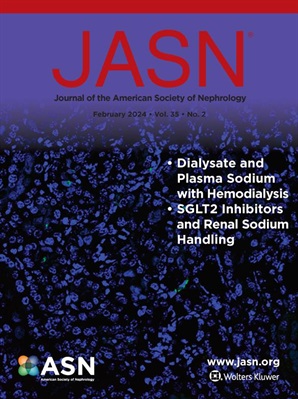Cardiac LIM Protein, Kidney Fibrosis, and Vascular Change after Acute Cardiorenal Syndrome.
IF 10.3
1区 医学
Q1 UROLOGY & NEPHROLOGY
引用次数: 0
Abstract
BACKGROUND Heart and kidney are bi-directionally interacting organs. Because heart and kidney disease are amongst the most common human diseases, investigating disease-causing interactions is important. Here, we identified a new role for cardiac-derived cardiac LIM protein, also known as cysteine-and-glycine-rich protein 3 (CSRP3), in acute cardiorenal syndrome. METHODS Mice, both wild-type and genetically-altered to remove CSRP3 from the myocardium, were subjected to a model of acute cardiorenal syndrome, cardiac arrest and cardiopulmonary resuscitation (CA/CPR), or ischemia-reperfusion injury. Recombinant CSRP3 was administered to mice subjected to ischemia-reperfusion injury, and CSRP3 uptake in the kidney was inhibited by pharmacologic means. RESULTS We found that CSRP3 transits the plasma after CA/CPR, and determined a kidney disease-modifying mechanism in which CSRP3 underwent megalin-dependent endocytosis in the renal proximal tubule and subsequently drove kidney fibrosis. Administration of CSRP3 to mice experiencing kidney injury exclusive of heart injury reproduced the kidney phenotype observed in CA/CPR mice. Genetic deletion of cardiac CSRP3 or proximal tubule megalin ameliorated cardiac arrest-induced chronic kidney injury. Translationally-relevant pharmacologic megalin inhibition also ameliorated CSRP3-mediated kidney phenotypic change, and administration of CSRP3 caused transcriptional change in the kidney. CONCLUSIONS We describe the endocrine role of cardiac CSRP3 in a previously unknown heart-kidney interaction which directs specific kidney dysfunction and renovascular remodeling after cardiac injury. These investigations elucidate a novel facet of the intricate coupling between heart and kidney after acute cardiorenal syndrome.急性心肾综合征后心脏LIM蛋白、肾纤维化和血管改变。
心脏和肾脏是双向相互作用的器官。由于心脏和肾脏疾病是最常见的人类疾病之一,因此研究致病的相互作用非常重要。在这里,我们确定了心源性心脏LIM蛋白(也称为富含半胱氨酸和甘氨酸的蛋白3 (CSRP3))在急性心肾综合征中的新作用。方法对野生型和基因改造的smice进行急性心肾综合征、心脏骤停和心肺复苏(CA/CPR)或缺血再灌注损伤模型的研究。重组CSRP3给药于缺血再灌注损伤小鼠,通过药理手段抑制CSRP3在肾脏的摄取。结果我们发现,在CA/CPR后,CSRP3在血浆中转运,并确定了肾脏疾病的改变机制,其中CSRP3在肾近端小管中进行巨噬蛋白依赖的内吞,随后驱动肾纤维化。在CA/CPR小鼠中观察到的肾脏表型中,给药CSRP3复制了不含心脏损伤的肾损伤小鼠。心脏CSRP3基因缺失或近端小管meggalin基因缺失可改善心脏骤停引起的慢性肾损伤。与翻译相关的药物抑制meggalin也改善了CSRP3介导的肾脏表型改变,并且CSRP3的给药引起肾脏的转录变化。我们描述了心脏CSRP3在先前未知的心脏-肾脏相互作用中的内分泌作用,这种相互作用指导心脏损伤后特定的肾功能障碍和肾血管重构。这些研究阐明了急性心肾综合征后心脏和肾脏之间复杂耦合的一个新方面。
本文章由计算机程序翻译,如有差异,请以英文原文为准。
求助全文
约1分钟内获得全文
求助全文
来源期刊
CiteScore
22.40
自引率
2.90%
发文量
492
审稿时长
3-8 weeks
期刊介绍:
The Journal of the American Society of Nephrology (JASN) stands as the preeminent kidney journal globally, offering an exceptional synthesis of cutting-edge basic research, clinical epidemiology, meta-analysis, and relevant editorial content. Representing a comprehensive resource, JASN encompasses clinical research, editorials distilling key findings, perspectives, and timely reviews.
Editorials are skillfully crafted to elucidate the essential insights of the parent article, while JASN actively encourages the submission of Letters to the Editor discussing recently published articles. The reviews featured in JASN are consistently erudite and comprehensive, providing thorough coverage of respective fields. Since its inception in July 1990, JASN has been a monthly publication.
JASN publishes original research reports and editorial content across a spectrum of basic and clinical science relevant to the broad discipline of nephrology. Topics covered include renal cell biology, developmental biology of the kidney, genetics of kidney disease, cell and transport physiology, hemodynamics and vascular regulation, mechanisms of blood pressure regulation, renal immunology, kidney pathology, pathophysiology of kidney diseases, nephrolithiasis, clinical nephrology (including dialysis and transplantation), and hypertension. Furthermore, articles addressing healthcare policy and care delivery issues relevant to nephrology are warmly welcomed.

 求助内容:
求助内容: 应助结果提醒方式:
应助结果提醒方式:


